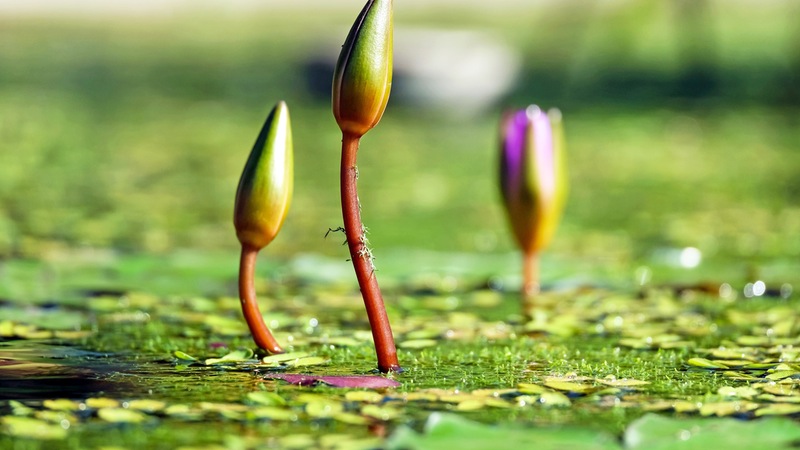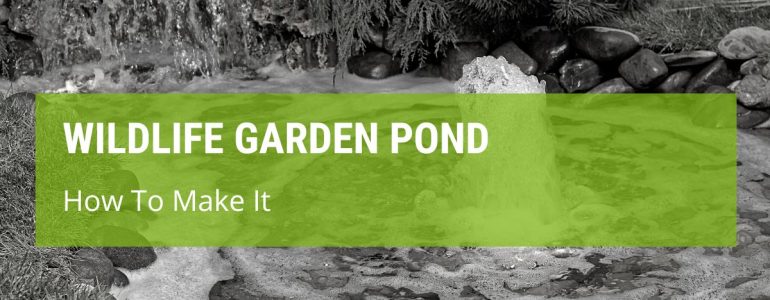Ponds are hotbeds of life, and can be great for all sorts of different types of wildlife. If you have been looking for ideas on how to make a wildlife garden ponds, then you’re in for a treat.
We are going to look at the best ways that you can make your own wildlife pond, no matter how big or small your garden is!
How To Make A Wildlife Garden Pond?

The first step is to work out where you want you pond to be. After this, you can decide that the place you put it is the perfect spot for it!
- You should pick a spot that is in as direct sunlight as you can find, to ensure that any plants get as much light as they can to photosynthesise.
- A liner is a good option for a wildlife garden pond, as this way you can work out what size you want your pond without having to stick within measurements.
- You can either just dig a pond and line it with black plastic, or buy a pre-made pond liner that is a size and depth that you want.
- Another option is a miniature garden pond, which can be a container – an advantage to this is that it can be moved if it does not get enough light.
- Add plants to the pond, preferably those which will attract pollinators as well as the usual pond life.
- You can either wait for the rain to fill up your pond or you can fill it with the hosepipe – if you use tap water, you should leave it a few days before you add any plants or fish.
This informative article will help you learn how to build a wildlife pond in your garden.
How Deep Should A Wildlife Pond Be?
2-3 feet at its deepest is considered to be a good depth for a wildlife pond. However, you should also have shallower areas too.
Making sure there is a shallow part in your pond will allow for more diversity in what comes to make your pond its home.
This variation in depth will also help any unfortunate animals that might fall in and not be able to swim out, such as hedgehogs.
The deeper your pond, the less likely it is to freeze over completely in the winter – but if you have pets or small children you should consider fencing it off.
For a pond to attract wildlife, if you are not planning on keeping fish, it doesn’t actually need to be too deep.
In fact, having a gently sloping shallower area is great for all kinds of wildlife – when the water levels fluctuate you will find the shallower area great for land dwelling creatures too.
Whatever the depth of your wildlife pond, you should include a ramp so that any animals that fall in can get out!
What Is A Good Size For Garden Wildlife Pond?
When you are placing a wildlife pond in your garden, it will need to fit your garden – you can’t fit a swimming pool sized pond in a high rise flat balcony!
Luckily, a wildlife pond will attract wildlife no matter what its size – even a small container will attract life.
As a general rule, the bigger the pond the more wildlife you will attract. A depth varying between 8 inches and 2 feet is ideal for the huge variety of wildlife.
Ponds that are around 6ft across are said to attract the largest amount, and greatest variety of wildlife.
However, you can make a perfect mini wildlife pond with just a washing up container, if this is all your space allows, and be confident that it will still be populated quickly.
Whatever the size of your garden, you can still create a beautiful pond that will attract all sorts of wildlife.
What Do You Put At The Bottom Of A Wildlife Pond?
Although most plants grow in soil, you don’t have to place a layer of mud at the bottom of your pond to encourage plants!
A layer of gravel should be all that you need to line your wildlife pond with. This allows plenty of hiding spaces for little organisms to live in your pond.
When you add your pond plants, try leaving them in their pots – this will not only allow them a growing medium but will also help to weigh them down.
You can also add a layer of sand to the bottom of the pond – this is great for little burrowing creatures that need a space to hide.
It’s a good idea to add some different sized pebbles too, as this adds a little variety and allows larger creatures a place to make their homes too.
Here’s a good video helping to decide what plants are the best to have in your garden pond:
Do Wildlife Ponds Need A Pump?
This type of pond is designed to be fairly self sufficient, so you shouldn’t have to add any aeration – if you do it properly, the plants will be adequate to oxygenate the water.
It is always good to encourage oxygenation in your wildlife pond – you should do this by having lots of oxygen-rich plants to prevent stagnation.
You can find water plants at just about any gardening store, and knowledgeable staff that will be able to help you decide which ones are best for you.
The water will almost certainly be kept moving by living creatures that swim or crawl through the water – but you can also give things a helping hand.
A solar powered fountain or water pump is a great idea for your wildlife pond; not only will this keep the water moving, but it won’t be too intrusive.
Final Words
A wildlife garden pond is a wonderful thing – for both the wildlife and for you. Hopefully we have given you some good ideas so you can enjoy a garden pond in your own garden, no matter how big!






